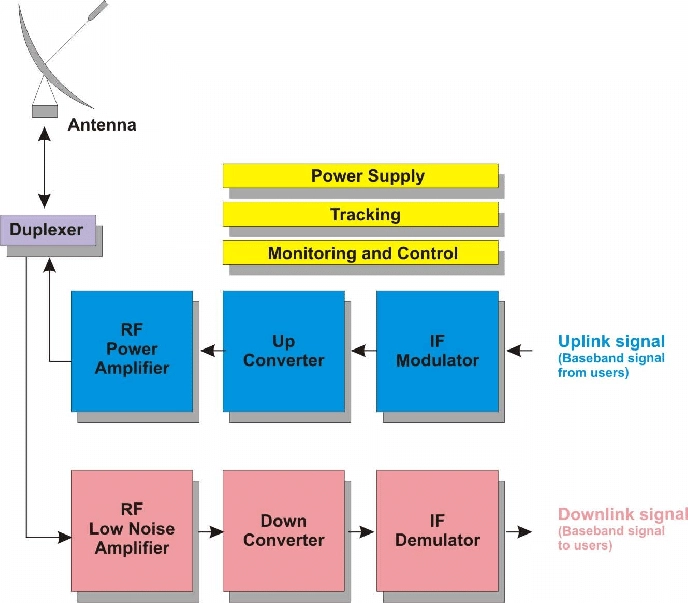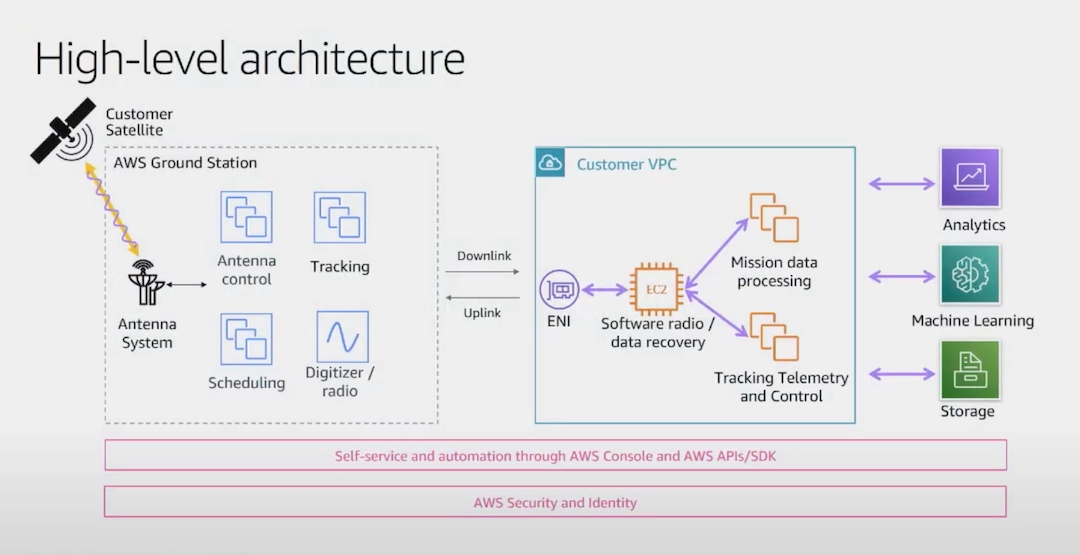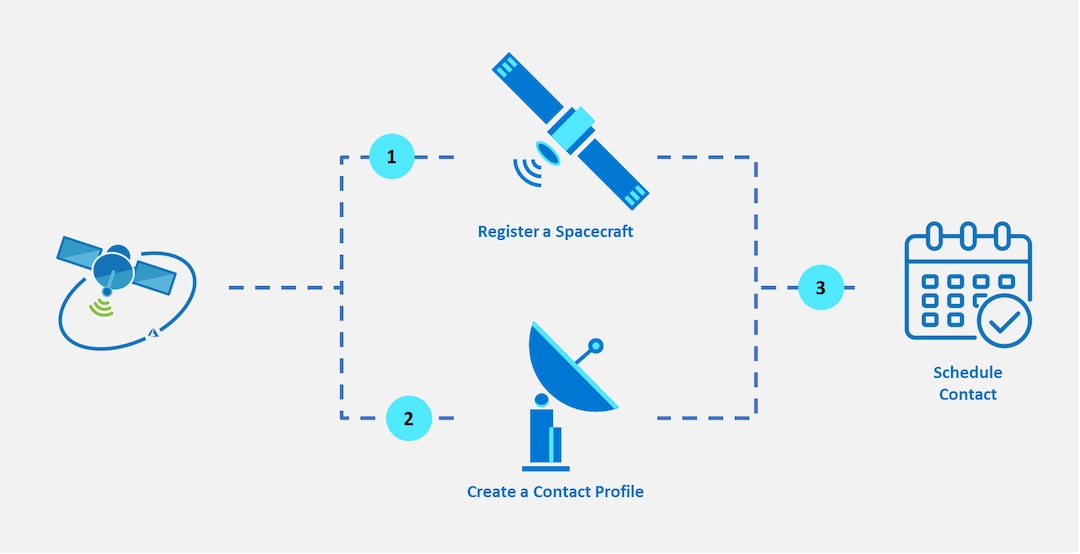Ground Station as a Service (or GSaaS) is Microsoft and Amazon's newest commercial offer for space customers. It is also their first step into being a player in the space economy. The concept? A virtualized satellite ground station in your own (virtual) network, with a pay per minute (yes, per minute) model.
Imagine a company willing to deploy a satellite network, let's say for specific Earth observation purposes. The cost of building and deploying satellites have decreased dramatically, still it is a very large capital expenditure, starting from around a million dollars per (small) satellite. And yet, you need to be able to communicate with the satellite to get that precious data. Ground stations are used to establish the radio link between the satellite and Earth.

A very-high level architecture of a satellite ground station, from Shkelzen Cakaj.
Owning one or multiple ground stations increases your capital and operational expenditure dramatically. Starting with construction, antenna cost dependency on frequency and gain, antenna physical (co)location with your network and ideal location may require doubling your capital expenditure, and multiplying by a few Xs your operational costs. As you scale your satellite operations, your requirements for upgrading your ground stations will scale accordingly as well. There are options for renting a ground station, however pricing is opaque (per deal/quote/provider) and it is still somehow expensive.
Ground Station as a Service (GSaaS) is a great solution for customers looking for connecting to their satellites at a reasonable cost. Its benefits are the following:
- Bring your own satellite. The satellite is owned/leased/rented by the customer directly. Microsoft and Amazon do not provide satellite services as part of Ground Station. Customers can concentrate in building the satellite and the application layer (if required) while knowing their ground station services are already available for use.
- Managed ground stations with global stations and network footprint. This would be the equivalent of building a multi-billion dollar infrastructure.
- No long-term commitment required.
- Simple, pay-as-you-go, pay per minute. Similar to other cloud services, it allows companies to run on a full OPEX model (excluding the satellites cost).
- Self-service scheduling, via APIs or console.
- Close proximity to Microsoft and Amazon regions (data centers).
- First-come, first-serve scheduling.
AWS Ground Station is the name of Amazon Web Services (AWS) offer and Azure Orbital (in preview) is Microsoft's. Their architectures are very similar, and are enabled by the use of Software Defined Radio (SDR) technologies, more specifically the VITA-49 protocol, for transporting Radio Frequency signals over IP (more exactly digitized RF/UDP/IP).

AWS Ground Station high level architecture. Property of Amazon.
In this service, the customer's satellite connects to an antenna system integrated into AWS or Microsoft clouds. The ground station sub-system owned by the Cloud provider includes the antenna, satellite tracking, scheduling, antenna control and the digitizer/radio systems.
The ground station is then virtually connected to the customer cloud (VPC in AWS and VNF in Azure). The connection happens per contact and the details are part of the contact profile. In order for this to happen, the customer needs to add a Software Modem into their virtual network, as the signal will be passed to them via the VITA-49 protocol (there is option for raw signal or extended data). This modem is hosted in a compute instance. Software modems are provided by the cloud ecosystem partners (e.g. Kratos Defense and Security Solutions, Amergint) who are fully integrated in their marketplace. From there, it is possible to leverage other cloud services for data processing (think of computer vision, machine learning), storage and others.
The solutions also integrate with other applications such as Mission Control (e.g. Major Tom from Kubos) for customers to build a full mission control with possibility of Telemetry and Command (TT&C) data.
The following are the key features provided by the AWS and Azure GSaaS offers:
- Support for satellites in Low-Earth (LEO) and Medium-Earth (MEO) orbits. AWS offers its own antenna systems: At least 2 5.4m antennas per location. Azure antennas are 6.1m diameter. Microsoft has also partnered with KSAT, US Electrodynamics, and Viasat to use their antenna systems.
- Global ground station coverage. As an example, AWS physical locations include Oregon, Ohio, Bahrain (Middle East), Stockholm (EU), Sidney/Australia (Asia Pacific), Ireland (EU), Cape Town/South Africa, with more stations (Hawaii, and more) planned. Microsoft current locations include Washington State, Sweden, South Africa, Singapore, Chile and Dubai.
- Support for S, X, and UHF bands. Bandwidth (and throughput) and link direction varies per band and type. UHF is still tagged as "coming soon" in both offers public documentation.
- Scheduling contacts via administrator console and API.
- Software Radio (and Forward Error Correction) to be located in customer virtual network.
- Network, management, automation, identity and security use the same services and framework as any other AWS or Azure cloud service. This is a huge advantage in cost and velocity of deployment when thinking about building any network and service.

Process of onboarding and scheduling a contact in Azure Orbital. Property of Microsoft.
Onboarding a new satellite into these services is straightforward, at least for now:
- Register a spacecraft: Customer contacts AWS Ground Station or Azure Orbital via e-mail expressing the intention and providing the necessary data, which includes the satellite NORAD ID, the transmit license and other data. Both providers would perform due diligence to validate ownership and/or right to operate, in order to license customer to operate (communicate with) the spacecraft.
- Create a contact profile: Customer creates a contact profile. This includes link characteristics such as carrier frequency, polarization, bandwidth, tracking requirements, etc. as well as customer network characteristics such as the VPC/VNF in which the digitized radio stream is going to be served.
- Schedule contact: This is a "search" function, in which the customer search for ground stations that can serve a specific contact (start/end date and time). The system will return results with the available options for the customer to reserve. Note the following caveats: It is a first-come first-serve system, so timing is critical. It is possible to reserve in advance (with up to 7 to 21 days in the case of AWS) to help customers with planning.
Pricing is one of the key surprising factors. As of January 2022, it can be as affordable as $3 USD per minute for a narrowband reserved link with AWS Ground Station service. At this time, given that Azure Orbital is still in preview, price is not yet public.
Who are the potential customers for a Ground Station Service?
Both AWS and Azure are focusing on two key customer use cases:
- Customers with Earth Observation satellites, both in commercial and public sectors. E.g. NASA has in their commercialization support plan, the migration of ground station needs to be served by the commercial sector. They have plenty of observation satellites. The US military also falls under this category of customers with large communications needs from satellites to Earth. And there is a myriad of private companies offering access to satellite imagery data which could benefit longer term of the convenience of the ground station service.
- Internet Service Providers, who rely on satellite communications both for primary and/or backup use. These Service Providers already have networks, however using Microsoft or AWS networks represent another level of scale, flexibility and operational efficiencies. Microsoft already established partnership with SES and Viasat for delivering global satellite network services, which will also leverage other Microsoft Services such as Microsoft Azure Modular Datacenter (MDC): A datacenter that could be placed anywhere on Earth, and connected to the Internet via satellite.
The availability of ground station services is a major step in creating affordable, global space-connected networks. However, this is just the beginning of something bigger. Imagine an datacenter in space servicing the upcoming space economy in the following decades!.
This article was completed in January 2021 with public information available from Microsoft and Amazon. Information around features, pricing, etc. will change over time
